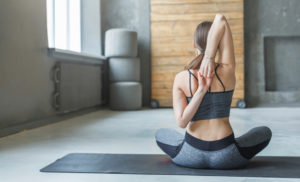Tortoise Pose

Meaning: In Sanskrit “Kurma” means tortoise. Tortoise Pose or Turtle pose.
Yoga types: Ashtanga, Hatha yoga, modern yoga.
Level: Advanced
Strengthens: Abdominal Muscles
Stretches: Spine And Legs
Asana includes various steps of Ashtanga yoga system:
- yama – social precepts
- niyama – personal practices of right living
- pranayama – regulation of energy related to breathing
- pratyahara – withdrawal of mental attachment to the objects of the senses
- dharana – concentration upon an object
- dhyana – meditative absorption into the essence of that object or idea
- samadhi – a unity of Self with the Universe.
Kurmasana Mythology
Kurmasana has deep roots in Indian mythology. According to legend, Vishnu – one of the most important gods in the Hindu pantheon, once became a tortoise in order to retrieve the nectar of eternal youth for the gods.
According to another myth, Vishnu was given birth to by a tortoise.
The Kurma picture is usually represented in painting in a mixed human-animal body. The human upper half is depicted wearing the same ornaments and holding the same weapons as in the usual images of Vishnu.
The Essence Of Kurmasana
Tortoise pose represents freedom from the world while existing in it. It represents the withdrawal of attachment to the desired senses until they are no longer able to rule the mind.
Yogi learns patience from the tortoise. It teaches us to work consistently on difficult tasks. This pose requires constant practice to do it.
Kurmasana represents how any task is typically approached in life and how this approach can be improved.
Benefits Of Kurmasana
Physiologically, Kurmasana is useful for our body because of the effect on the hip joints and leg muscles. This is the best pose for stretching the joints. Also, the inner thigh muscles and back hamstrings are given a full stretch.
- Stimulates abdominal organs
- Heals back problems
- Lengthens the spine and opens shoulders
- Improves the digestive and respiratory systems
- Relaxes your neck and shoulders
- Increases blood flow to the brain
- Helps people who suffer from asthma
- Withdraws senses
- Quiets the mind, stretches the nervous system
- Makes body flexible and toned
How To Do Kurmasana
- Sit down in Dandasana with your legs straight in front of you. Place your hands alongside your hips. Press your thighs into the ground. Bring your legs to the edges of your mat with your knees as wide as your shoulders.
- Bend your knees and bring your feet closer to your hips. Place your arms forward and down in between the legs and bend your torso down and forward along with the arms. Stay here for a few breaths.
- Bend your knees further and put your shoulders under your knees. Stretch your arms to the sides. Gently press your inner thighs to your shoulders to bring your chest down. Make sure that your inner thighs touch your side ribs.
- Extend your arms sideways and bring down your head. Hold this pose for 5 deep breaths.

Get a Free Guide for Improving Your Yoga Practice
Yoga is a way to achieve inner balance, to promote a unique attitude to life, and deepen the spiritual way to live.
We at The Wild Essence want people to feel good, that’s why we inspire people to practice yoga.

Improving your yoga practice will help you:
get more creative and widen your possibilities
see your own practice in a new light
keep your yoga practice forever evolving
Sign up with your email address to receive a free PDF.
We want to say thank you for Yogi @m.a.lorenzo from Instagram. Her asana photo is our featured image.
Tortoise Pose Meaning: In Sanskrit “Kurma” means tortoise. Tortoise Pose or Turtle pose. Yoga types: Ashtanga, Hatha yoga, modern yoga. Level: Advanced Strengthens: Abdominal Muscles Stretches: Spine And Legs Asana includes various steps of Ashtanga yoga system: yama – social precepts niyama – personal practices of right living pranayama – regulation of energy related to breathing pratyahara – Read More
Read More







